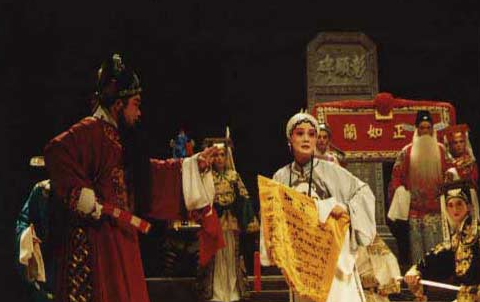|

Min Opera, also called Fuzhou Opera, is the only opera sung in the Fuzhou dialect. It reached its peak after the 1911 Revolution. It is popular in Fuzhou and central, eastern and northern Fujian, where the Fuzhou dialect is spoken. It is also popular in the Malay Archipelago.
Min Opera tunes are made up of Yangge, Jianghudiao, Douqiang and Xiaodiao tunes and are accompanied by horizontal flutes, suona, touguan, erhu, yehu, Qing drums, war drums, gongs, cymbals and chime stones. Min Opera roles are classified into twelve categories; Xiao-sheng (handsome gentlemen), Lao-sheng (virtuous old men), Wu-sheng (young warriors), Qing-yi (stately, dignified ladies), Hua-dan ( vivacious young girls), Lao-dan (old women), Da-hua (actor with a painted face, category I), Er-hua (actor with a painted face, category II), San-hua (actor with a painted face, category III), Tie, Mo and Za. Actors try to reflect characters' mentality through their body movements.
There are more than 1,000 Min Opera plays, most of which originated from folk tales, historical novels and ancient legends, such as 'Making Seals', 'The Purple Jade Hairpin' and 'Switching Fairy Peach with Litchi'.
Min Opera is first out of Fujian's Five Operas and is more than 400 years old. It is very important for studying the development of Fuzhou culture and theatre. Nowadays, because of the impact of the modern economy, Min Opera is in danger of dying out and therefore is in great need of salvation and protection.
Source: chinaculture.org
|
